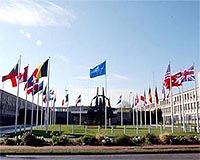| . |  |
. |
Hong Kong (UPI) May 19, 2009 One member of the Russian military delegation to last November's Zhuhai Air Show described the Chinese-Russian arms trade as being in a long and drawn-out winter. A representative of Rosoboronexport, the agency that handles exports of Russian defense equipment, declined to comment on China's possible export of J-10A fighters equipped with Russian AL-31F engines. China did have its own indigenous engine on display at the show, the Taihang turbofan engine, with a thrust power of 13,200 kilograms, or 29,101 pounds. However, some experts say it is only 12,800 kilograms -- 28,219 pounds. The Taihang's exterior design and modular structure, as well as the processing and polishing technologies of the core machine and engine blades, seem to be an improvement over China's previous aviation engines, but it is still far behind similar systems from Russia and Western countries. Representatives of China's Liming Motor Corp. refused to answer questions about the engine's performance features. It is unclear why China decided to introduce this engine to the international market when it has not elected to use it on its own J-10 fighters. A Chinese military source said China has been promoting the J-10A to Egypt, but it appears that no substantial negotiations have yet taken place. An authoritative source from the Russian military industry has said that Russia will not allow China to use its engines in exported planes if it perceives such sales as having a negative impact on Russia's own export market. Egypt was once a major client of Russian arms, though it now buys little other than spare parts. Pakistan, on the other hand, is not a traditional client of Russian aircraft. Therefore, Russia allowed its engines to be used on the JF-17 fighters China is developing with Pakistan. The same arrangement may therefore hold for the J-10A. The basic price for the J-10A is about $29.3 million, according to the Chinese source. Considering that China aims to sell this fighter primarily to oil-producing countries -- and is prepared to trade it for oil and other natural resources -- it could be an attractive option for such countries. A general assessment of the export version of the J-10A fighter can conclude that its engine has less thrust than the F-16 Block 52, while its radar system is more or less on par with the Zhuk-ME multifunction radar on the Russian MiG-28 SMT. This is because Russia's Phazotron Design Bureau exported to China three sets of its Zemchug multi-role radar systems after 2001, allowing China to come up with its own version of the Zhuk-ME radar. This radar has a detection range of 120 kilometers, or 75 miles, for 5-square-meter aerial targets and can attack four targets in the air simultaneously. In terms of the diversity and performance of its weapon systems, especially long-range attack weapons, the J-10A lags far behind the F-16 Block 52. The air-to-air missiles loaded on the J-10A fighter at the Zhuhai exhibition were SD-10A AAMs with compound hard points. The SD-10A is a medium-range active radar-guided air-to-air missile upgraded from the SD-10, with its maximum range extended to 70 kilometers, or 43 miles. Its length is 3.9 meters, around 13 feet; diameter, 203 millimeters, around 8 inches; weight, 198 kilograms, just under 440 pounds, and maximum speed Mach 5, 3,800 miles per hour at sea level. The PL-12 air-to-air missiles currently in service in the People's Liberation Army Air Force have undergone similar upgrading. Short-range missiles include the new-generation PL-5EII and PL-9C. The PL-5EII is equipped with a multichannel infrared seeker, the latest laser proximity fuse and a rocket motor with a non-smoke propellant. The air-to-ground weapons on the J-10A mainly include the LT-2 laser-guided bomb and the FT series of Global Positioning System-guided bombs. In recent years, China has been imitating U.S. aviation combat weapons, a trend that is reflected in the weapon platforms on the J-10A, including its imitation U.S. joint direct attack munition serial bombs.
Related Links The Military Industrial Complex at SpaceWar.com Learn about the Superpowers of the 21st Century at SpaceWar.com
 NATO In The Early 21st Century: Part Six
NATO In The Early 21st Century: Part SixWashington (UPI) May 19, 2009 As the first decade of the 21st century ends, the European member states of the North Atlantic Treaty Organization are moving in a somewhat leisurely manner to modernize their already technically advanced weaponry with more high-tech systems. But they are making no moves to increase the size of their military establishments. On the contrary, French President Nicolas Sarkozy, whose natio ... read more |
|
| The content herein, unless otherwise known to be public domain, are Copyright 1995-2009 - SpaceDaily. AFP and UPI Wire Stories are copyright Agence France-Presse and United Press International. ESA Portal Reports are copyright European Space Agency. All NASA sourced material is public domain. Additional copyrights may apply in whole or part to other bona fide parties. Advertising does not imply endorsement,agreement or approval of any opinions, statements or information provided by SpaceDaily on any Web page published or hosted by SpaceDaily. Privacy Statement |